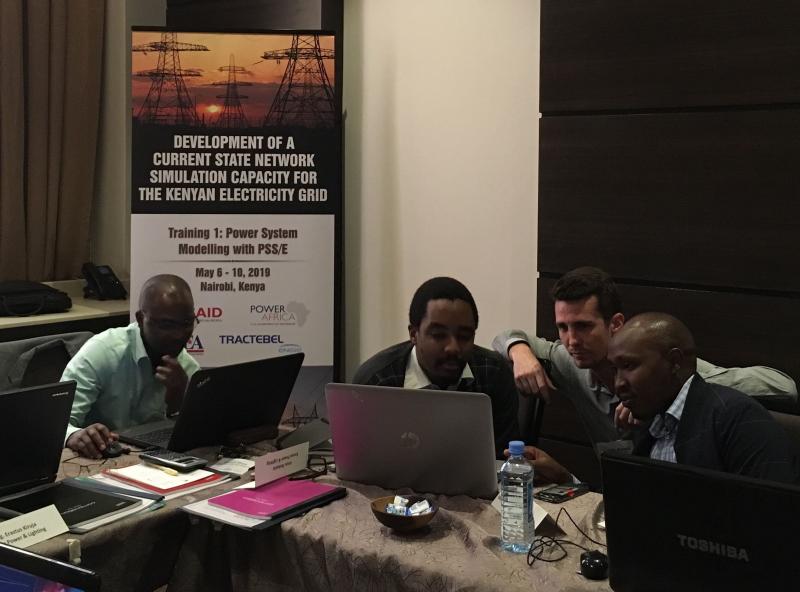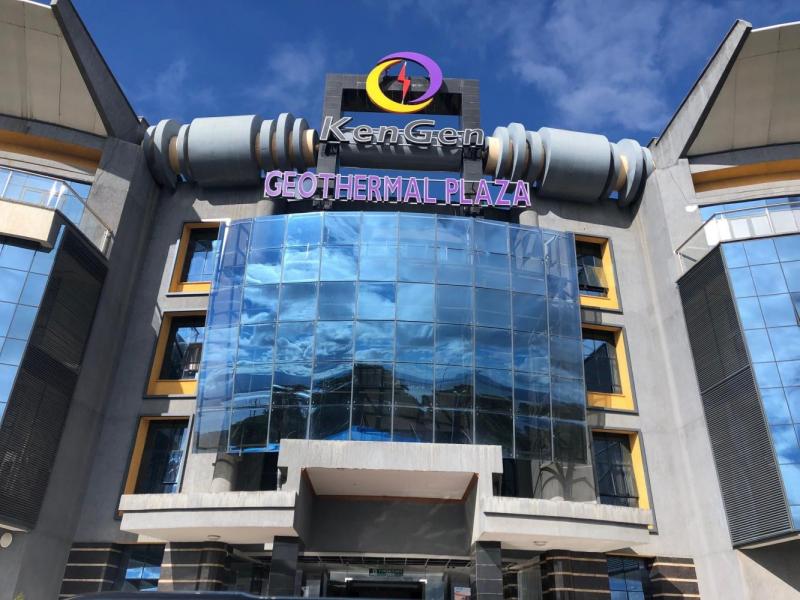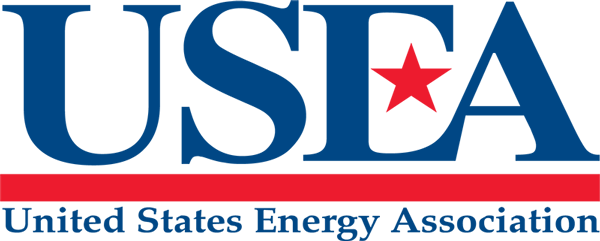Kenya
Kenya has one of the most developed power sectors in sub-Saharan Africa, with Independent Power Producers (IPPs) and abundant renewable energy resources, especially geothermal, wind, and solar. Limited and aging transmission and distribution infrastructure, financing, opaque procurement processes, right-of-way disputes, and other challenges affect their ability to expand and reach 100% universal access. EUPP was been active in Kenya from 2010-24, working with the generation, transmission, and distribution utilities to integrate renewables, increase generation, and improve system operations.
Integrated Load Flow Planning Model Completed
The EATP Working Group completed the development of East Africa’s first integrated load flow planning model for the 2020 planning horizon. The model features all transmission network and generation elements for 110 kV and higher voltage networks for Kenya, Ethiopia, Tanzania, Rwanda, Uganda and Burundi. The regional model provides the EATP and EAPP with a powerful tool to forecast system investment requirements to accelerate regional clean energy and trade. Additionally, each utility was left with a platform to analyze internal network investments needed to increase electrification in their respective country.
EKT Wheeling Methodology Created
Under EUPP, the Ethiopia-Kenya-Tanzania (EKT) methodology to enable the sale of electric energy by Ethiopian Electric Power (EEP) to Tanzania Electric Supply Company (TANESCO) and the wheeling of electric energy through the Kenyan transmission system by KETRACO was created. This methodology will determine wheeling tariff prices for energy Ethiopia sells to Tanzania and sends through Kenya. Through input given, the EKT Wheeling Methodology will be a document that may well be replicated in other regions of sub-Saharan Africa.
Kenyan Current State Security Analysis study completed
This study consists of analyzing several steady state aspects for the 2020 Kenyan power system and evaluates its performance under normal operation and for a selected set of credible contingencies. The study provided a Load Flow and Contingency Analysis, recommendations for Corrective Actions, Inertia/Governor Load Flow Calculations, Voltage Stability Analysis and Reactive Power Planning.
KenGen needs to drill over 400 new geothermal production and injection wells in the Olkaria Geothermal Field by 2025 in order to meet the “Good to Great” geothermal expansion goals; however, the drilling of wells in the Olkaria field by KenGen drilling teams was taking considerably longer than the industry average. By improving the skills of KenGen’s internal drilling teams through multiple trainings on fishing, wells are drilled in a more efficient and safe manner, allowing for new power plants to come online on schedule. KenGen has since been able to reduce its average duration to complete a geothermal well, in part due to this training with Baker Hughes in Dubai.
Conceptual Model and Olkaria Numerical Model Reports
As part of Kenya’s “Good to Great” strategy, KenGen plans to add an additional 500MW of geothermal energy generation to the Olkaria field by 2023. While preparing for this rapid increase in production, there is a need for accurate reservoir modeling to ensure that the development of the reservoir is sustainable. KenGen worked with numerous outside consultants and international aid agencies to build and improve the reservoir model for Olkaria; however, with the recent and planned accelerated development, a need was identified to have the past reservoir modeling work reviewed and verified.
EUPP2 partnered with ThermoChem, a U.S. geoscientific firm, to work side-by-side with KenGen reservoir management staff to build KenGen’s capacity to produce in-house numerical and conceptual reservoir models. As a result of this support, KenGen was able to produce its first in-house reservoir models in 2022, allowing them to save significant consulting costs and improving its understanding of its key geothermal resource.
Increasing Oserian Industrial Park’s Geothermal Capacity
EUPP2 conducted a comprehensive feasibility study that included the design and financial modeling for the implementation of a high voltage interconnection to the Kenyan national grid for backup power to ensure industrial park clients do not experience service interruptions. The project is in the development phase, ensuring synchronized operation between OTLP’s mini-grid and KPLC’s distribution network. Implementing this connection will provide OTLP with the power redundancy to support their master plan and maintain their commitment to eventually be powered by 100% renewable energy resources.
EUPP2 completed a feasibility and design study for the Oserian Development Company (ODC) to develop a steam pipeline that connects the industrial parks OW-202 and OW-306 geothermal power plants with additional steam from KenGen to boost energy production. The study included the design criteria basis for the new pipeline, preparation of detailed steam pipeline drawings, specifications, and data sheets. The objective of the study is to increase the generation output of the OW-306 power plant from an average of 0.4 MW to above 1.2 MW. EUPP2 and its advisory team completed a bill of materials detailing the required parts and equipment and delivered preliminary design drawings to Oserian in March 2023. The pipeline extension for the Oserian Development Company's geothermal plant is currently under construction, a direct result of the EUPP2 assistance.
KENYA UTILITY PARTNERSHIP (2017-2024)
The Kenya Utility Partnership began in 2017, with the start of USEA’s current Energy Utility Partnership Program. Capacity building is directed to the Kenya Power and Light Company (KPLC), the Kenya Electricity Transmission Company Limited (KETRACO), the Kenya Electricity Generating Company (KenGen), and the Energy Regulatory Commission of Kenya (ERC). Currently, the partnership is providing capacity building on the development and application of a current state network simulation model for Kenya on which to perform power system studies to improve system reliability and security. KPLC and KETRACO utilize PSS/E power system planning and analysis tools for transmission planning, network stability, and grid operation studies. For this purpose, the KPLC has maintained a more accurate load flow network PSS/E model.
KENYA TRANSMISSION OPERATIONS (KETRACO) PARTNERSHIP (2015-2024)
The Kenya KETRACO Partnership promoted best practices in transmission system operations and planning. The partnership focused on best practices related to resource and transmission planning, project management, asset management, operations and dispatch, and creating the EKT wheeling methodology.
KENYA WIND PARTNERSHIP (2015)
The Kenya Wind Integration Partnership was a one year program focused on how the Kenyan system could safely integrate and dispatch wind energy from the Lake Turkana project. The majority of the program focused on dispatcher training and how to adjust for intermittent wind without Automatic Generation Control. Senior dispatchers from KPLC, KETRACO, KenGen and the Electricity Regulatory Commission learned best practices in wind integration through workshops and dispatcher training.
KPLC Hires U.S. Firm to Continue Dispatcher Training
In 2017-2018, KPLC directly hired a U.S. company IncSys to continue dispatch training that began under EUPP. IncSys and PowerData, another U.S. firm, provided the PowerSimulator software hosted on the cloud with the KPLC-specific model. IncSys also provided training on how to use PowerSimulator with the KPLC system-specific model. The continued training of dispatchers will improve reliability and allow more renewables to be integrated into the grid.
Dispatcher Training Exposed Problems With Future System
The wind generation integration dispatcher trainings for KETRACO, KenGen and the Electricity Regulatory Commission in Kenya led to the discovery of several potential problems with Kenya’s planned system. As a result of discovering there is a lack of generation reserves at Lessos, KPLC commissioned a second 30MW Gas Turbine unit at Muhoroni and fast tracked a 220kV transmission line between Olkaria and Lessos to help evacuate more power and sort out the voltage issues.
EAST AFRICA GEOTHERMAL PARTNERSHIP (EAGP)
The EAGP was launched in 2012 to promote the development of geothermal energy resources and projects in East Africa. The EAGP program is a partnership between USAID and USEA, to encourage and facilitate the involvement of the U.S. geothermal industry in the region. EAGP focuses on six priority countries: Djibouti, Ethiopia, Kenya, Rwanda, Tanzania, and Uganda.
Through EAGP, USEA provides technical and transaction advisory support and capacity building to public organizations and government ministries involved in geothermal development in the region through executive exchanges, workshops and short-term technical assistance assignments to learn about geothermal best practices from their counterparts in the U.S. and third countries.
Facilitated U.S. Business Connections
Through the EAGP-sponsored exchange program to the GEA Expo and GRC Annual Meeting, Ethiopian and Kenyan geothermal officials made contacts with over 70 U.S. firms that supply many of their needed goods and services. EAGP delegates and their senior colleagues in attendance were able to generate new interest in the EA geothermal market among a larger audience of U.S. companies, through presentations on opportunities and procurement needs in EA (organized by EAGP and GEA). The successful event has resulted in a plan to engage U.S. industry members to give feedback on GDC’s, and possibly KenGen’s, tender design. This will improve GDC’s ability to execute transactions related to their goods and services tenders.
Provided Guidance for Development of East African Geothermal Centre of Excellence
Worked with industry experts and advisors to provide feedback and guidance based on the findings of the Icelandic International Development Agency (ICEIDA) Feasibility Study for the East African Geothermal Centre of Excellence and help to design curricula for the Centre
Assisted with Creation of Joint Development Agreement for PPPs
EAGP facilitated a short-term technical assistance program for Kenya’s GDC on producing a joint development agreement for PPPs in geothermal development. EUPP worked with GDC and MoF on the legal structures, financially viable project structures for PPPs and developed a set of recommendations for GDC and produced a market assessment of GDC’s proposed joint development structures.
Assisted in Development of Geothermal Strategies
Provided support to USAID and Power Africa Transactions and Reforms Program (PATRP) in updating and implementing the Power Africa Multi-Donor Geothermal Strategy for East Africa and assisting USAID in developing its own internal Power Africa inter-agency geothermal strategy
NILE EQUATORIAL LAKES SUBSIDIARY ACTION PROGRAM (NELSAP) PARTNERSHIP
Kenya is a member of USEA’s regional Nile Equatorial Lakes Subsidiary Action Program (NELSAP) Partnership. In 2016 and 2017, the NELSAP Partnership focused on capacity building activities for NELSAP member states (Ethiopia, Kenya, Rwanda, Tanzania and Uganda) on the issues of contract and project management. EUPP facilitated several regional workshops for project management specialists, engineers, financial analysist and legal advisors from East African utilities on contract development and negotiations, best practices in procurement, risk management, and dispute resolution. Workshop deliverables included customized project management documents and templates, as well as action plans for regional utilities to improve their contract and project management practices.
In 2019, the NELSAP Partnership’s focus shifted to power trading with the following objectives:
-
Creating awareness among regional power industry stakeholders on possible mechanisms for allocation and compensation for ancillary service costs, as well as energy storage alternatives, based on U.S. and other international practices;
-
Providing senior regional government officials and utility management with clear understanding of the existing gaps in the current set-up of ancillary services in the East African region;
-
Creating a platform for generating sustainable discussions among East African energy stakeholders on policy, regulatory and market barriers for developing both local and regional ancillary and energy storage markets.
EASTERN AFRICA POWER POOL PARTNERSHIP (EAPP)
Kenya is a member of USEA’s regional Eastern Africa Power Pool (EAPP) Partnership that currently focuses on advanced modeling and long-term planning. USEA will facilitate a series of training programs on load flow modeling and conducting security analyses using PSS/E software platform. These trainings will address insufficient levels of modeling and planning capacity among EAPP planning staff and planning committee members in individual countries. It will also build EAPP’s capacity in the advanced application of the PSS/E software, specifically in advanced power flow, contingency, voltage stability and dynamic analysis, transmission planning, power system operation, and the integration of renewable energy and HVDC systems.
Power Trading in Ancillary Services and Energy Storage in East Africa: A Roadmap drafted and submitted to USAID.
EASTERN AFRICA REGIONAL TRANSMISSION PLANNING PROGRAM (EATP)
The Eastern Africa Regional Transmission Planning Program (EATP) was conducted in 2014 – 2018 to foster regional cooperation in transmission planning and analysis between Ethiopia, Burundi, Kenya, Tanzania, Rwanda, and Uganda. The EATP developed the capacity of transmission planners in Kenya, Ethiopia and Tanzania to develop regional electric power transmission corridors that will (1) serve as the backbone infrastructure for trade and exchange of electricity, (2) enable investment in new electric power generation plants, (3) support integration of clean energy generation resources, and (4) improve system reliability. The EATP created a Working Group that continued to further refine the national planning models to support regional harmonization and reviewed regional models. The Working Group members include the following organizations: the Eastern African Power Pool, EEP, Kenya Electricity Transmission Company, Ltd., KPLC, TANESCO, Régie de Production et Distribution d'Eau et d'Electricité, Rwanda Energy Group, Ltd., and Uganda Electricity Transmission Company, Ltd. Under EUPP, the EATP developed regional network planning models, beginning with a load flow model for East Africa, progressing to dynamic models over time. The members of the EATP Working Group were trained to prepare each of the models, expanding the pool of qualified network planners in East Africa to continuously fine tune the regional planning model. Topics covered under this partnership included:
-
EATP Regional Network Load Flow Models;
-
EATP Load Flow and Dynamic Training;
-
Study to Calculate Losses for the EKT Wheeling Transaction; and
-
NELSAP/TRACTABEL Study Review.
National Power Balance Settling
The development of a consensus for settling national power balances (import/export) within the regional model for each country. The national power balances will form the basis of the network analysis to be completed using the 2020 load flow model.
Development of a Regional Project Tracker
The initiation of a Project Tracker to determine the probability of commissioning generation and transmission projects within the planning horizon being analyzed (2020).
Adoption of Terms of Reference
EATP countries adopted a Terms of Reference to conduct a sensitivity analysis of regionally significant candidate transmission investment projects using agreed upon parameters.
Self-Assessment Dynamic Modeling and Analysis Tool Developed
The creation of an EATP Self-assessment Dynamic Modeling and Analysis Tool to enable transmission utilities to identify network planning institutional and human resource and capacity deficits and benchmark their capacity against one another.
Creation of Standard Operating Procedures Manual
The creation of a step-by-step Standard Operating Procedures Manual that outlines the planning criteria, defines strict requirements and gives directions and recommendations for construction, usage and update of the EATP regional model in load flow software.
ENGENDERING UTILITIES PARTNERSHIP (2015-2017)
Historically, the power sector has been dominated by males - this is particularly true in the developing world. In recognition of and to assist in reducing the barriers caused by the gender gap in the power sector, USEA conducted an Engendering Utilities Partnership in coordination with USAID from 2015 through 2017. The partnership aimed to identify and transfer policies and corporate programs that support increased female participation in the power sector. The partnership was launched with utilities from Georgia, Jordan, Kenya, Macedonia, and Nigeria in order to help the utilities grow and adapt with the community they serve.
The Engendering Utilities Partnership helped these utilities to improve their gender policies and gender achievements by improving labor market achievements, contributing to greater operational efficiencies, increasing profits, enhancing their corporate image, and improving branding opportunities. Through the partnership, EUPP introduced best practices to the member utilities in increasing female recruitment through the introduction of gender-specific hiring techniques, creating an informal mentoring program for women; implementing gender-inclusive policies and procedures; customer service and engagement; and succession planning.




